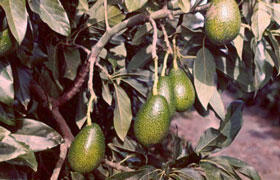


Home
Flowers &
Indoor Plants
Fruits & Nuts
Ornamentals
Vegetables
Special Topics
Resources
Glossary

|
Avocado Persea americana (per-see-uh ah-mer-ih-can-uh) Click on thumbnails for larger image. |
 |
What about it? The avocado has some unlikely relatives: cinnamon, sweet bay, and sassafras. This evergreen tree thrives in warm areas such as southern California. It gets to be about 20-40 feet tall, although many dwarf cultivars are available. The leaves are 4-8 inches long, while the fruit is 3-6 inches long and rather pear-shaped. The flesh of the fruit is yellow-green in color, with a creamy texture. What is it used for? The avocado tree is used as a specimen tree, and for its shade. Dwarf varieties are often grown in containers. The avocado is mainly enjoyed for fresh eating; many people love guacamole, the garlicky condiment made with avocado fruit. The avocado is rich in oil and vitamin B, and is low in sugar. Avocado oil is commercialy extracted from the fruit. Avocados are an important crop in Central America. Where does it grow? How do we grow it? Deep, well-drained soil is essential for growth. Root death in poorly-drained and poorly-aerated soils can be severe. Light or medium texture soils are preferred. Avocados are very susceptible to frost and to strong winds. Shelter from the wind is required to prevent flower and fruit fall. Avocados are large trees. Mature trees should be spaced 24 to 36 feet apart. What are its primary problems? Some people consider the large leaves that drop a nuisance. Root rots are a major cause off ill health and death of trees. Anthracnose is also a serious disease. Other pests found on avocados include the leaf roller, caterpillar, greedy scale, and thrips. How do we harvest and store it? Avocadoes are cut from the tree with pruners, with the stem attached to the fruit. You can store ripe avocados at cool temperatures, ripe avocados will not last long!
© Copyright, Department of Horticulture, Cornell University. |